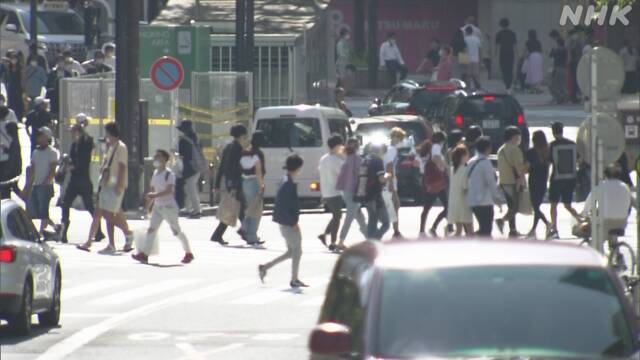"Self-restraint rate" First Sunday after cancellation in 39 prefectures Declined nationwide New Corona May 19 16:33
The National Institute of Informatics estimated an index "self-restraint" that indicates how much people refrained from going out with the new coronavirus countermeasures. The self-restraint rate has decreased.
This is analyzed by groups such as the National Institute of Informatics and Canon Global Strategy Research Institute, while protecting the privacy of the information of NTT Docomo mobile phone base stations.
"Self-restraint rate" is an estimate of how many people went out from the difference between the daytime and nighttime populations in areas with a lot of houses, and is the percentage of those who went out compared to the January average.
As a result, on the 17th of the month, which was the first Sunday after the declaration of emergency in 39 prefectures was lifted, all prefectures except Shimane prefecture had lower self-restraint from the previous Sunday.
Of these, the self-restraint rate continued to decline even in eight prefectures designated as special vigilance prefectures:
▽ Tokyo decreased 6.0 points from the previous week by 55.2%,
▽ Kanagawa prefecture decreased by 5.8 points from the previous week. 53.0%,
▽ Saitama prefecture decreased by 4.1 points from the previous week 48.1%,
▽ Chiba prefecture decreased by 6.7 points from the previous week 47.3%,
▽ Hyogo prefecture decreased by 7.6 points from the previous week 45.6%,
▽ Osaka prefecture in front From the
previous week fell 8.8 points to 45.5%, ▽ Kyoto prefecture dropped 7.0 points from the previous week to 43.3%, and
▽ Hokkaido fell 6.5 points to 40.0% from the previous week.
On the other hand, regarding the 39 prefectures where the declaration was lifted
, Toyama prefecture, which was the highest, dropped 4.6 points from the previous week to 45.3%, and
▽ Ishikawa prefecture next fell 2.8 points from the previous week to 44.6%, and
▽ Nara prefecture to the previous The 6.7 points decreased from the week to 44.1%, and the
self-restraint rate continued to exceed 30% in 34 prefectures.
Associate professor Takayuki Mizuno of the National Institute of Informatics, who conducted the analysis, said, "It seems that self-restraint is becoming more and more relaxed in specified caution prefectures. It is necessary for the economic recovery to show appropriate measures such as styles and eliminate anxiety. "
Self-restraint rate on Sunday 17th
《Specific warning prefectures》
(1) Tokyo 55.2%, (2) Kanagawa 53.0%, (3) Saitama 48.1%,
(4) Chiba 47.3%, (5) Hyogo 45.6%, (6) Osaka Prefecture 45.5%,
(7) Kyoto Prefecture 43.3%, (8) Hokkaido 40.0%
《Cancelled 39 Prefectures》
(1) Toyama Prefecture 45.3%, (2) Ishikawa Prefecture 44.6%, (3) Nara Prefecture 44.1%,
(4) Shimane 43.8%, (5) Gifu 41.9%, (6) Aichi 41.8%,
(7) Ibaraki 40.9%, (8) Fukui 39.9%, (9) Wakayama 39.9%,
(10) Fukuoka 39.8%, (11) Shiga 39.0%, (12) Gunma 38.7%,
(13) Nagano 38.4%, (14) Hiroshima 37.9%, (15) Tochigi 37.7%,
(16) Shizuoka 37.4% , (17) Okayama 37.3%, (18) Fukushima 37.2%,
(19) Yamaguchi 37.0%, (20) Yamagata 36.4%, (21) Yamanashi 36.2%,
(22) Oita 36.2%, ( 23) Kagawa prefecture 35.9%, (24) Ehime prefecture 35.0%,
(25) Niigata prefecture 34.9%, (26) Mie prefecture 34.3%, (27) Tokushima prefecture 34.2%,
(28) Kochi prefecture 34.2%, (29) Kumamoto prefecture 34.1%, (30) Miyagi prefecture 33.1%,
(31) Okinawa prefecture 32.1%, (32) Iwate prefecture 31.4%, (33) Tottori prefecture 30.5% ,
(34) Saga prefecture 30.5%, (35) Nagasaki prefecture 29.8%, (36) Miyazaki prefecture 29.2%,
(37) Akita prefecture 28.9%, (38) Kagoshima prefecture 27.0%, (39) Aomori prefecture 25.1%
(decimal point) Rounded up to the second place)
Self-restraint rate on Monday 18th
《Specific warning prefectures》
(1) Tokyo 49.0%, (2) Kanagawa 44.6%, (3) Chiba 38.9%,
(4) Saitama 36.9%, (5) Osaka 33.8%, (6) Kyoto Prefecture 31.0%,
(7) Hyogo prefecture 30.7%, (8) Hokkaido 22.8%
《Cancelled 39 prefectures》
(1) Nara prefecture 30.9%, (2) Ishikawa prefecture 29.3%, (3) Okinawa prefecture 29.0%,
(4) Fukuoka 28.8%, (5) Shiga 26.2%, (6) Aichi 26.1%,
(7) Gifu 25.9%, (8) Ibaraki 25.5%, (9) Kumamoto 25.2%,
(10) Gunma 24.4%, (11) Fukui prefecture 24.0%, (12) Hiroshima prefecture 23.8%,
(13) Toyama prefecture 23.5%, (14) Yamaguchi prefecture 23.5%, (15) Yamanashi prefecture 23.0%,
(16) Tokushima prefecture 22.9% , (17) Shizuoka 21.9%, (18) Tochigi 21.9%,
(19) Okayama 21.0%, (20) Nagano 20.9%, (21) Wakayama 20.8%,
(22) Miyagi 20.4%, ( 23) Mie prefecture 20.1%, (24) Niigata prefecture 20.0%,
(25) Fukushima prefecture 19.9%, (26) Kagawa prefecture 19.9%, (27) Shimane prefecture 19.9%,
(28) Oita prefecture 18.1%, (29) Ehime Prefecture, 17.8%, (30) Kochi Prefecture 17.3%,
(31), Yamagata Prefecture, 17.2%, (32) Nagasaki Prefecture 16.3%, (33), Miyazaki Prefecture 15.5%,
(34) Sasaki Prefecture 13.8%, (35) Kagoshima Prefecture 12.2%, (36), Tottori Prefecture 11.2%,
(37), Iwate Prefecture, 10.5%, (38) Akita Prefecture 8.9%, (39) Aomori Prefecture 8.0%
rounded off (the first decimal place )

